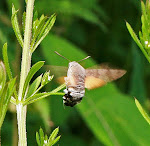Raft spiders (Dolomedes spp.) of which only two species occur in Britain and Europe, are the largest spiders we have. Both are rare with the Fen Raft Spider (Dolomedes plantarius) exceptionally so and only known from three well separated U.K. localities. Although more common than the Fen Raft Spider, the ordinary Raft Spider (D. fimbriatus) is still scarce and has a very patchy British distribution pattern. In northern England it occurs only at a few sites in a very limited area of south Cumbria in small acidic pools in raised bogs. These pools may only be a metre or so in extent. Otherwise, the closest sites are in Shropshire.
.jpg)
[Dolomedes fimbriatus near Haverthwaite]
The spiders' bodies can measure over 20mm and, with their legs outstretched, they may cover a diameter of over 70mm; the females are the larger of the two sexes.
.jpg)
Although they can be found on nearby vegetation, being semi-aquatic they are most easily observed at the pools. There they wait at the margins with their rear legs holding onto the vegetation, ready to quickly run across the water surface in pursuit of prey. This is thought to include damselflies, other small insects and even small fishes. If threatened, the spiders will submerge in an instant, the fine hairs covering them helping to envelop them in an air bubble and enabling them to breathe under water.
.jpg)
[The spiders' typical small acidic pool habitat near Haverthwaite]
.jpg)
[Anchored to the vegetation by its rear legs, waiting for prey]
At this site several were seen in the sunny conditions, one of these was smaller and of a paler colouration than the others and presumably a juvenile.
.jpg)
[Juvenile, near Haverthwaite]
.jpg)






No comments:
Post a Comment